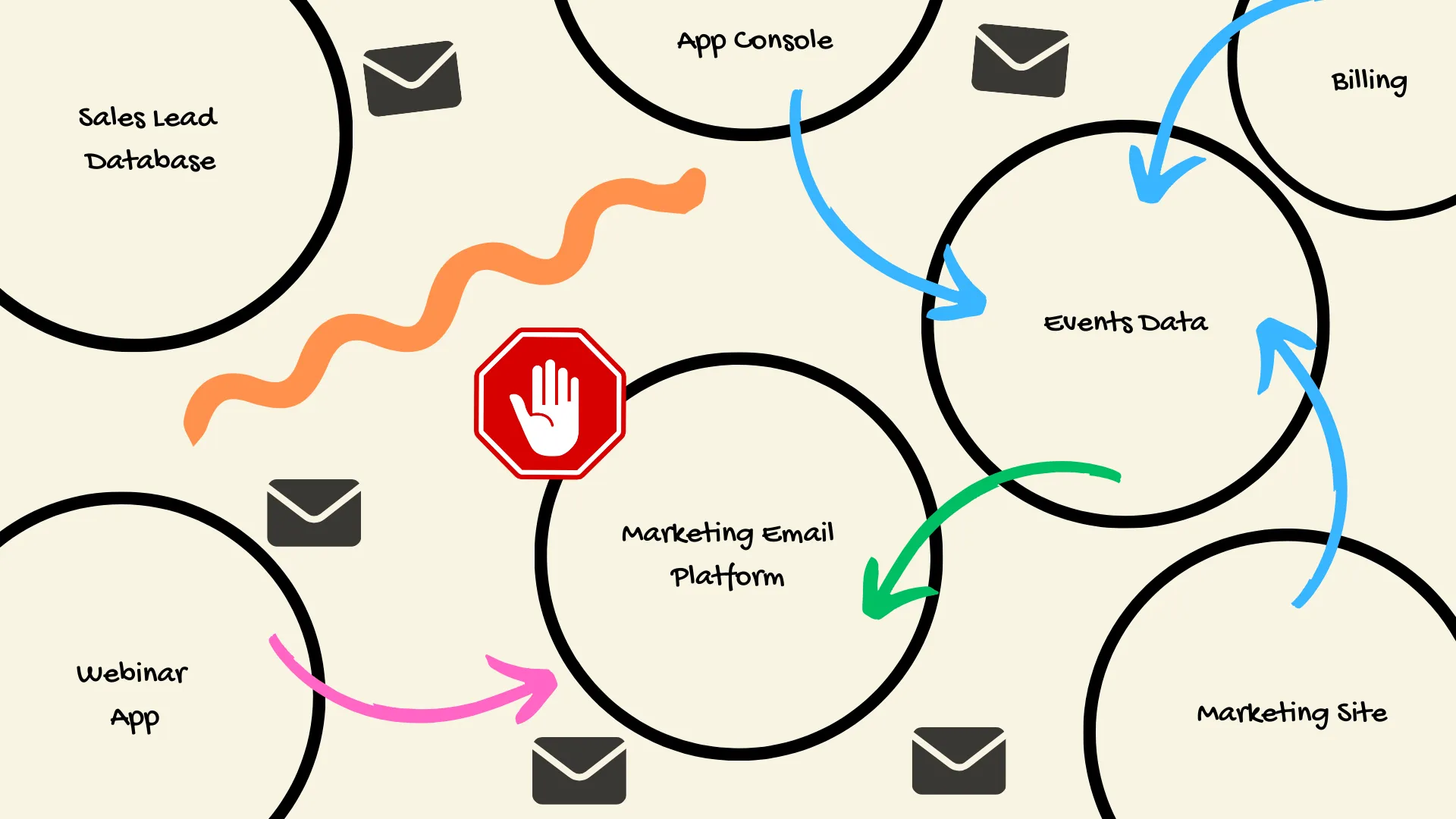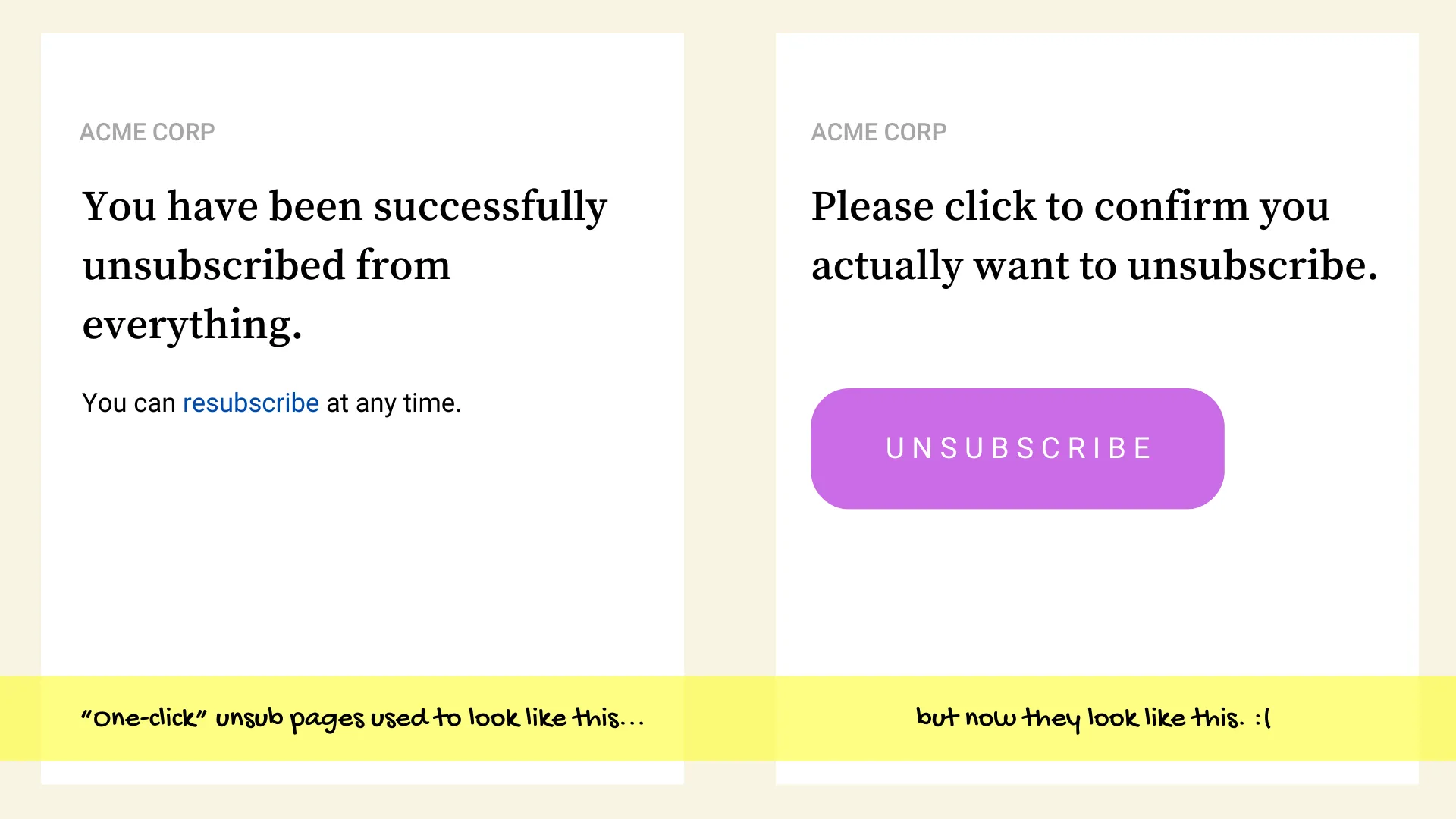
Bring back permission-based marketing
Deep down, I’m a big fan of permission-based marketing. I believe you should be able to:
- Know how a business acquired your contact information
- Give or deny consent to receive communications when you transact with any service
- Set preferences for how you’d like to receive different types of information—email, call, text, mail
- Easily change your preferences without authenticating into a product
- Opt out of all promotional comms from any brand with a single click
I also believe there are many business owners who want to run their marketing communications this way, but they are not equipped for the implementation.
Too many messages from disconnected tools
Modern marketing platforms make it easier than ever to segment customers and trigger messages based on data-driven events, either on the marketing site or in the product. But these services do a poor job of surfacing logic to customers and governing communications according to their preferences.
 This is the simplified version.
This is the simplified version.
When you start layering on bespoke tools for specialized parts of the marketing motion—one tool for cold sales outreach, one for email newsletters, another for surveys, for reviews, for product-driven campaigns—it becomes practically impossible to manage a centralized system for customer permissions.
To make things worse, aggressive companies may use third-party tools to “enrich” your visitor profile based on your IP address, guessing your work email and mapping your phone number to your site activity before you’re ever ready to willingly type it in.
As a customer, you may find yourself wondering:
How the heck did you even get my cell phone number?
How many times do I have to reply ‘STOP’?
Why does your email system need 15 days to process my unsubscribe request?
In response, we rely on our email clients and phone settings to protect ourselves from the onslaught of messages we can’t control.
We get so many spam calls, we set our phones to “do not disturb” and configure an allowlist for friends and family only.
We filter out text messages from unknown senders.
We build our own email filters to automatically trash mail from retailers because the unsubscribe links never seem to work.
And, don’t even get me started on the new unsub pages that make you click yet another button to double-confirm that you really want to opt out. If it’s a true one-click unsubscribe link, you should get a “thank you” page. That’s it. Double confirmations should be for opt-ins, not opt-outs.
 Blame it on the “inbox bots.”
Blame it on the “inbox bots.”
Meanwhile, businesses are receiving angry responses, being marked as spam, ruining their sending reputations, and wondering why their email deliverability is getting worse over time.
Few business owners wake up with the intention of being spammy or creepy, but the software systems they’re sold lead them into fail states. It’s too hard to make this not suck.
Where is the unified message preference center as a service?
As a marketer, I wish that I could wire up a universal message preference center that actually works.
One where, customers could:
- Audit how their information got into my company’s system
- Give or revoke consent for specific types of branded promotions, universally
- Understand whether an unexpected message was transactional, operational, or a configurable notification that’s part of the product experience
- Confirm whether they’d like to accept physical mail, like thank you cards or SWAG, to a physical address at a home office or HQ
- Mark themselves “do not text” or “do not call”
- Opt out of everything—and maybe even cancel their subscription or start a data deletion request, if needed
From a marketing operations perspective, I’d want to:
- Hook in my favorite martech apps
- Map which preference types govern specific campaigns
- Learn which forms, webhooks, and data-driven events add people to segmented lists related to specific preference types
If enough brands starting using the same service, maybe it could learn to do some neat tricks like:
- Suggest undiscovered newsletters or promos based on your preferences
- Surface brands you haven’t interacted with recently, to prompt whether you’re still interested
- Sync info like “do not call me” or physical mailing preferences across multiple trusted brands
Of course, if you make it easier for customers to take back control over the types of communications they receive, that means that you as a marketer have to:
- Treat your campaigns more like products, providing continuous value
- Consider the relevance and frequency of messages you send, to avoid triggering a more enforceable (and punishing) opt out
- Be willing to operate with a leaner subscriber base overall
But wouldn’t that make us better marketers? Why are we so afraid of making it easy for people to say they don’t want to hear from us any more?
We believe in “easy to buy, easy to cancel” for our favorite apps. Why wouldn’t we apply the same philosophy to our marketing messages?
Manual ops as a stopgap solution
The unified message preference center of my dreams does not exist yet, as far as I know. (If you’re building something in this space, please let me know!)
Even if it did exist, it’s unclear whether many customers would prefer this level of configurability instead of simply letting their Gmail Promotions tab floweth over. Most people aren’t as religiously inbox zero as I am. I may be an outspoken outlier here.
Right now, as a professional marketer, I have to be pragmatic and incorporate best practices that serve customers with respect while working within the constraints of my current stack.
That means little things like:
- Including verbose descriptions about how people were subscribed to a list in every email footer
- Doing some manual segmentation work to ensure I can provide a global unsubscribe in every marketing email
- Investigating every unsubscribe complaint to ensure they’re effectively opted out of all branded campaigns—not just the subscription type related to their complaint.
Messaging ops as an opportunity for differentiation
At the end of the day, only the strongest businesses can afford to lean into permission-based marketing. You have to have enough brand awareness—through word of mouth or paid campaigns—to trust that the right people will come to you and want to subscribe.
Once you earn someone’s subscription, the messaging preference experience itself is an overlooked area where you could have the opportunity to differentiate.
If you can afford to invest in making your messaging operations less broken, you may set yourself apart from the less serious business next door.